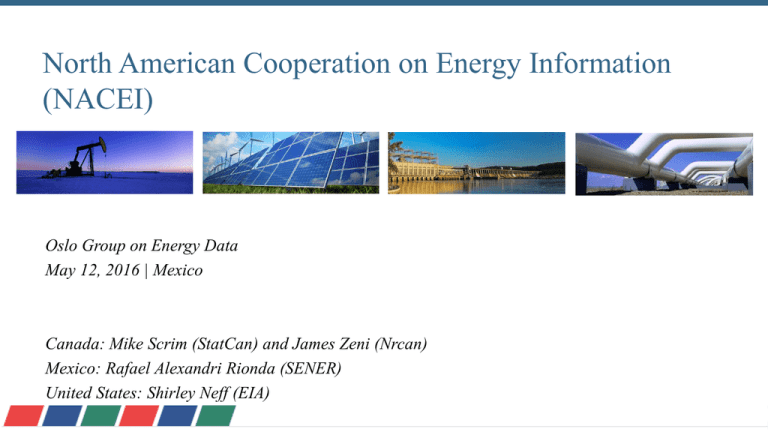North American Cooperation on Energy Information (NACEI)
advertisement

North American Cooperation on Energy Information (NACEI) Oslo Group on Energy Data May 12, 2016 | Mexico Canada: Mike Scrim (StatCan) and James Zeni (Nrcan) Mexico: Rafael Alexandri Rionda (SENER) United States: Shirley Neff (EIA) Independent Statistics & Analysis www.eia.gov Goals of trilateral cooperation on energy information A. Energy trade statistics Consistent energy trade data across and within jurisdictions; harmonized methods and definitions; aligned international reporting practices B. Geographic energy information Fully integrated maps of North American energy infrastructure C. Outlooks for energy supply and demand Process for exchanging views and projections of cross-border energy flows D. Cross reference for energy terminology Catalogue of concepts, terms and definitions consistent across North America and translated into each country’s official language(s) North American Cooperation on Energy Information 2 Milestones in cooperation Jun-2015 180-day progress report Dec-2014 MOU Signed 1 Feb-2016 nacei.org website launched & MOU expanded to include climate change 2 Apr-2015 Meetings in Mexico City 3 4 5 Oct-2015 Meetings in Washington D.C. North American Cooperation on Energy Information 6 Jun-2016 Additional mapping layers launched 3 New Trilateral website: www.nacei.org • Hosted by U.S. EIA and launched on February 12, 2016 at North American Energy Ministerial in Winnipeg • Currently provides access to each of the three Trilateral country’s websites • Over coming months, migrate all information products onto NACEI portal in three official languages (English, French and Spanish) for easier access and maintenance • Make use of open data development for efficient updating of data series North American Cooperation on Energy Information 4 A) Energy Trade Data Statistics North American Cooperation on Energy Information 5 Energy Trade Data Statistics: Summary • Tables and graphs presenting respective country energy trade data for easy comparison have been compiled and a tool for systematic and efficient refreshing of data tables is in development • Graphical examples demonstrating variations in data series have been posted • Guide detailing the specific methodologies for each country’s energy trade data series has been developed • Glossary cross referencing terminology used by the Trilateral countries and the International Energy Agency (IEA) and the United Nations (IRES) has been developed for ease of analysis and to help identify opportunities for harmonization • Commodity sub-working groups (liquids, natural gas, electricity) have been established and dialogue has been initiated for targeted adjustment and improvements. North American Cooperation on Energy Information 6 Energy Trade Data Statistics: Crude oil and condensate Variations exist between U.S., Mexican, and Canadian data sets and the graphs demonstrate visually the need for harmonization across the three countries. Conduct systematic comparison of crude oil and equivalents definitions by statistical data source and associated data series, supported by cross reference glossary, to facilitate understanding and ensure coherence in reporting and dissemination. North American Cooperation on Energy Information 7 Energy Trade Data Statistics: Natural Gas Close alignment for Canada to U.S. flow, between the U.S. Energy Information Administration (EIA) and the Canada National Energy Board (NEB), some adjustment applied by Statistics Canada to NEB data. More discrepancy between EIA and NEB for U.S. to Canada flows, however closer match between Statistics Canada and NEB. Micro-level data analysis, by border crossing, to be organized by EIA to verify U.S.-Canada, and U.S.-Mexico flows. Note: Prior to the energy reform in Mexico, PEMEX was the sole data source. There are now multiple entities involved in gas trade. SENER recognizes the need to develop a survey. North American Cooperation on Energy Information 8 Energy Trade Data Statistics: Electricity Electricity flow data from Canada to the United States is fairly consistent because it is primarily based on NEB data. EIA is collecting and testing its own electricity import/export information collection. Electricity flow data from Mexico to the United States is fairly consistent because it is primarily based on actual interchange data. Mexican import data is augmented with other import data not captured by actual interchange. EIA’s new collection uses several measures and will likely be the closest of all sources to a census for all flows. Data set will be used for micro-level analysis and verification between U.S.-Canada, and U.S.-Mexico. North American Cooperation on Energy Information 9 Hourly Electric System Operating Data • EIA has been collecting and will soon be posting publicly near real-time hourly data on the operation of the U.S. electric system • Availability of data will inform investments in technologies and programs to take advantage of the time varying nature of electric system operations • Data collection and a highly visible webpage will serve situational awareness, policy, and educational objectives • Readily accessible long-term data series will support analysts interested in intra-day and seasonal patterns of demand • Mexico has signed on to participate; Canada to encourage provinces to do the same North American Cooperation on Energy Information 10 B) Geographic Energy Information North American Cooperation on Energy Information 11 Geographic energy information: North American Energy Maps now available via NACEI portal • Interactive maps (Link to video) are now available on each country’s website using common underlying data and information with functionality to: – Display over 20 different elements – Obtain information on individual facilities – Change base\background map – Change zoom level • Static maps are also available with text, labels and legends in 3 languages for: – Natural Gas Processing Plants – Liquefied Natural Gas Import and Export Terminals – Refineries and Upgraders – Electric Power Plants – Renewable Electric Power Plants • Underlying data on energy infrastructure across North America available in Excel and Shapefile format North American Cooperation on Energy Information 12 Geographic energy information: Next steps for 2016 • Continue validation of GIS data and expand energy infrastructure maps to include renewable energy resource layers and cross border pipeline and transmission line points • Working towards goal of releasing expanded NA maps with new layers at Clean Energy Ministerial in San Francisco in early June • Develop a consolidated web map viewer that will be made available on the NACEI web portal North American Cooperation on Energy Information 13 C) Trilateral Energy Outlook D) Cross References for Energy Terminology North American Cooperation on Energy Information 14 Trilateral Outlook for Energy Supply & Demand • A report from the Trilateral Energy Outlook Project focused on identifying areas where further coordination and understanding could yield the greatest mutual benefit • A comparison was developed of the respective modeling frameworks for each country's current official projections with a particular focus on understanding cross-border trade • The results of using a common set of assumptions across all three countries, while maintaining the same respective models and methods used by each, produced national outlooks displayed to the left Note: Estimates were provided by each country using a limited set of common assumptions and do not necessarily reflect the countries’ own individual outlooks; combined results do not reflect an integrated tri-country model and may contain unresolved inconsistencies. North American Cooperation on Energy Information 15 Cross reference for energy terminology North American Cooperation on Energy Information 16 Lead Agencies and Partners North American Cooperation on Energy Information 17 Lead Agencies Canada Mexico United States Department of Natural Resources Secretariat of Energy Department of Energy Minister James Carr Secretary Joaquín Caldwell Secretary Ernest Moniz Jay Khosla, Assistant Deputy Minister for the Energy Sector Leonardo Beltrán Rodriguez, Deputy Secretary for Planning and Energy Transition Adam Sieminski, Administrator of U.S. Energy Information Administration (EIA) James Zeni, Chief of Economic Analysis & Statistical Information Rafael Alexandri Rionda, General Director for Planning and Energy Information Shirley Neff, Senior Adviser to the Administrator of EIA North American Cooperation on Energy Information 18 Partners United States Mexico • Department of Energy − Energy Information Administration • Secretariat of Energy • • National Electricity Control Center National Hydrocarbons Commission • • National Natural Gas Control Center National Statistics and Geography Institute • • Energy Regulatory Commission National Energy Control Center • PEMEX • Federal Electricity Commission − Office of Fossil Energy • U.S. Census Bureau Canada • Natural Resources Canada • National Energy Board • Statistics Canada North American Cooperation on Energy Information 19 Supplemental Slides North American Cooperation on Energy Information 20 Geographic energy information: North American Energy Maps contain multiple elements of information North American Cooperation on Energy Information 21 Geographic energy information: Renewable Power Plants, 1 MW or more North American Cooperation on Energy Information 22 Geographic energy information: Tools to display detailed view and individual facility information North American Cooperation on Energy Information 23 Map Data Files • Shapefiles and spreadsheet files available on the individual elements and by country • Provides flexibility to public users to select any or all datasets • Uniform table and file structure allows for easy merging and comparing • Updating country level data by element will be more frequent and easier for developers North American Cooperation on Energy Information 24 Static map of North American Natural gas processing plants North American Cooperation on Energy Information 25 Static map of North American Liquefied natural gas import and export terminals North American Cooperation on Energy Information 26 Static map of North American Refineries (including asphalt and upgrader facilities) North American Cooperation on Energy Information 27 Static map of North American Electric Power Plants (100 MW or more) North American Cooperation on Energy Information 28 Static map of North American Renewable electric power plants (1 MW or more) North American Cooperation on Energy Information 29



